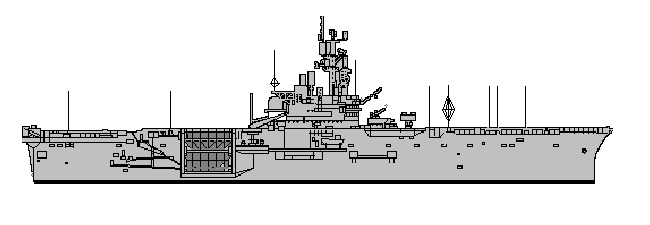
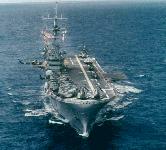
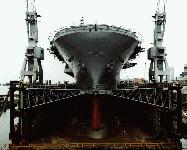
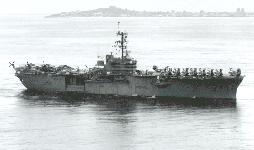
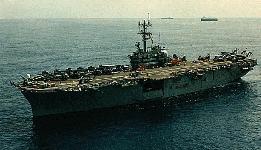
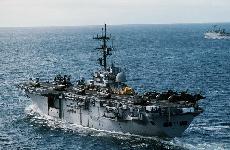





Deployed to the Persian Gulf as part of the military forces which ultimately would be used to drive Iraqi forces from Kuwait, on 30 October 1990 Iwo Jima (LPH 2) suffered a high-pressure steam leak that cost the lives of 10 of its crew, but repairs kept her fully operational. A steam turbine valve in the fireroom sustained a catastrophic mechanical failure. This failure resulted in the release of superheated steam at a temperature of 850 degrees Fahrenheit into the fireroom. The Iwo was "stricken" in September 1995 and scrapped in Philadelphia, then towed upriver. The hulk was sold as scrap in August of 1996 for $140,000 to Mystic Shipping and Trading Co. and she was towed to New Orleans.
USS Inchon served as a key element of the US Naval Amphibious Forces 1970 to 1994 in both the Atlantic and Pacific Fleet. Inchon was converted from an amphibious assault ship to a dedicated command, control and support ship for mine countermeasures operations. The contract to convert Inchon was awarded in November 1994 to Ingalls Shipbuilding, Inc., Pascagoula, MS. USS Inchon was redesignated for its new mission on 24 May 1996 after undergoing a 15 month conversion and overhaul. Major changes were made to the Command, Control, Communications, Computers and Intelligence (C4I) system, with upgrades including the close-in weapons system (Phalanx) and various radars. The ship supports an embarked composite helicopter squadron of eight CH-53E and two SAR/spotter helicopters. It provides an alongside support, resupply and repair facility for up to four Avenger (MCM 1) Class mine countermeasures ships and Osprey (MHC 1) Class coastal minehunters. It can support and accommodate four Explosive Ordnance Disposal (EOD) groups with assigned equipment. Additionally it provides C4I facilities for the MCM group commander. New repair facilities and upgrades to older one were also added, giving the MSC 12 the ability to accomplish whatever repairs are necessary to weapons, LCACs, and aircraft in any theater of operation.
Specifications | |
| Power Plant | Two boilers, one geared steam turbines, one shaft, 22,000 total shaft horsepower |
| Length | Overall Length: 598 ft
Waterline Length: 556 ft |
| Flight Deck Width | 104 feet (31.2 meters) |
| Beam | 84 feet (25.2 meters) |
| Draft |
Maximum Navigational Draft: 29 ft Draft Limit: 30 ft |
| Displacement |
Light Displacement: 13465 tons Full Displacement: 19395 tons Dead Weight: 5930 tons |
| Speed | 23 knots (26.5 miles per hour) |
| Aircraft | (actual mix depends upon mission) 11 - CH-53 Sea Stallion helicopters 20 - CH-46 Sea Knight helicopters 1 - UH-1 or SH-3 as SAR helicopters 3 - UH-1 Marine Corps helicopters 3 - AH-1 Marine Corps helicopters |
| Crew |
Ships Company: 80 officers, 638 enlisted Marine Detachment: 1,750 |
| Armament | 2 - 20mm Phalanx CIWS |
| Unit Operating Cost Annual Average | ~$32,500,000 [source: [FY1996 VAMOSC] |
Ships | ||||||
| Name | Number | Builder | Homeport | Ordered | Commissioned | Decommissioned |
| Iwo Jima | LPH 2 | Puget Sound NSY | Norfolk | 30 Jan 1958 | 26 Aug 1961 | 14 Jul 1993 |
| Okinawa | LPH 3 | Philadelphia NSY | San Diego | 24 Oct 1958 | 14 Apr 1962 | 17 Dec 1992 |
| Guadalcanal | LPH 7 | Philadelphia NSY | Norfolk | 21 Dec 1959 | 20 Jul 1963 | 31 Aug 1994 |
| Guam | LPH 9 | Philadelphia NSY | Norfolk | 21 Sep 1961 | 16 Jan 1965 | 25 Aug 1998 |
| Tripoli | LPH 10 | Ingalls | San Diego | 10 Dec 1962 | 06 Aug 1966 | 15 Sep 1995 |
| New Orleans | LPH 11 | Philadelphia NSY | San Diego | 18 Dec 1964 | 16 Nov 1968 | 01 Oct 1997 |
| Inchon | LPH 12 | Converted to Mine Countermeasures Support Ship | ||||
| NOTE: The LPH designation has been applied to a variety of dissimilar ships. To further confuse matters, the numbering sequence is non-sequential. LPH 1 was Block Island [ex CVE-106] LPH 4-6 were converted Essex-class [CV-9] carriers CV-40 Tarawa, an Essex-class [CV-9] carrier, operated with helicopters, without the LPH designation. |
||||||






